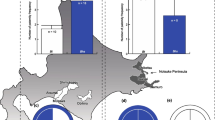Abstract
Artificial hybridization experiments involving 25 taxa ofRuellia had as one objective to determine the possibility of any genetic relationships between North American temperate species and certain widespread tropical American taxa. The results confirm a close morpho-genetic link betweenR. caroliniensis-R. pedunculata and the Caribbean species R.geminiflora and betweenR. nudiflora and the pantropical R.tuberosa. A second objective was to test the genetic basis for the present generic concept ofRuellia. The results of hybridizations among species representatives of six proposed segregate genera were measured by relative seed-set in crosses. The results support the view that the present circumscription of the genus is unnatural and that some taxa presently classified inRuellia bear little if any morphological or genetic relationship toRuellia. When the ecotype concept is applied to the genus, natural, closely related species groups can be identified by hybridization experiments. This approach can lead to an accurate, precise delimitation ofRuellia and may be applicable in other large genera of Acanthaceae.
Similar content being viewed by others
Literature cited
Baur, E. 1914. Einführung in die experimentele Verebungslehre. 2nd ed. Berlin.
Bentham, G. & J. D. Hooker 1886. Genera Plantarum. London.
Bremekamp, C. E. B. 1969. An annotated list of the Acanthaceae collected by Miss W. M. A. Brooke on her travels in Bolivia. Koninkl. Nederl. Akademie van Wetenschappen, Ser. C72: 420–430.
— &N. E. Nannenga-Bremekamp 1948. A preliminary survey of the Ruelliinae (Acanthaceae) of the Malay Archipelago and New Guinea. Verh. Kon. Ned. Akad. Wetensch., Afd. Natuurk., Tweede Sect.45: 1–39.
Clausen, J. 1951. Stages in the Evolution of Plant Species. Ithaca.
Grant, W. F. 1955. A cytogenetic study of the Acanthaceae. Brittonia8: 121–149.
Leonard, E. C. 1927.Ruellia tuberosa and a few of its close relatives. J. Wash. Acad. Sci.17: 509–520.
— 1951. The Acanthaceae of Colombia. Contr. U.S. Natl. Herb.31: 1–117.
Lindau, G. 1895. Acanthaceae.In A. Engler & K. Prantl (eds.), Die natürlichen Pflanzenfamilien 4(3b): 274–354.
Long, R. W. 1963. Mass collections ofRuellia in Florida. Yearb. Amer. Philos. Soc. 338–341.
— 1964. Biosystematic investigations in South Florida populations ofRuellia (Acanthaceae). Amer. J. Bot.51: 842–852.
— 1966. Artificial interspecific hybridization inRuellia (Acanthaceae). Amer. J. Bot.53: 917–927.
— 1970. The genera of Acanthaceae in the southeastern United States. J. Arnold Arbor.51: 257–309.
— 1973. A biosystematic approach to generic delimitation inRuellia (Acanthaceae). Taxon22: 543–555.
Lundell, C. L. 1966. Flora of Texas.1:223–282. Renner, Texas.
Mather, K. 1947. Species crosses inAntirrhinum. I. Genetic isolation of the speciesmajus, glutinosum, andorontium. Heredity1: 175–186.
Müller, F. von 1892. Mischlinge vonRuellia jormosa undsilvaccola. Abh. Naturwiss. Vereine Bremen12: 379–387.
Nobs, M. A. 1963. Experimental studies on species relationships inCeanothus. Publ. Carnegie Inst. Wash. 623.
Prazmo, W. 1960. Genetic studies on the genusAquilegia L. I. Crosses betweenAquilegia vulgaris L. andAquilegia ecalcarata Maxim. Acta Soc. Bot. Poloniae29: 57–77.
Skalinska, M. 1958. Seed development after crosses ofAquilegia withIsopyrum. Studies in Plant Physiol. (Prague)1958: 213–221.
Straw, R. M. 1956. Floral isolation inPenstemon. Amer. Naturalist90: 47–53.
Turreson, G. 1922. The genotypical response of the plant species to the habitat. Hereditas3: 211–350.
Author information
Authors and Affiliations
Additional information
Research supported by grants GB-35231 and GB-1026 from the National Science Foundation. I thank C. P. Sreemadhavan, Martha Meagher, and Suzanne Todd, who served as assistants.
Rights and permissions
About this article
Cite this article
Long, R.W. Artificial interspecific hybridization in temperate and tropical species of ruellia (acanthaceae). Brittonia 27, 289–296 (1975). https://doi.org/10.2307/2805899
Issue Date:
DOI: https://doi.org/10.2307/2805899




